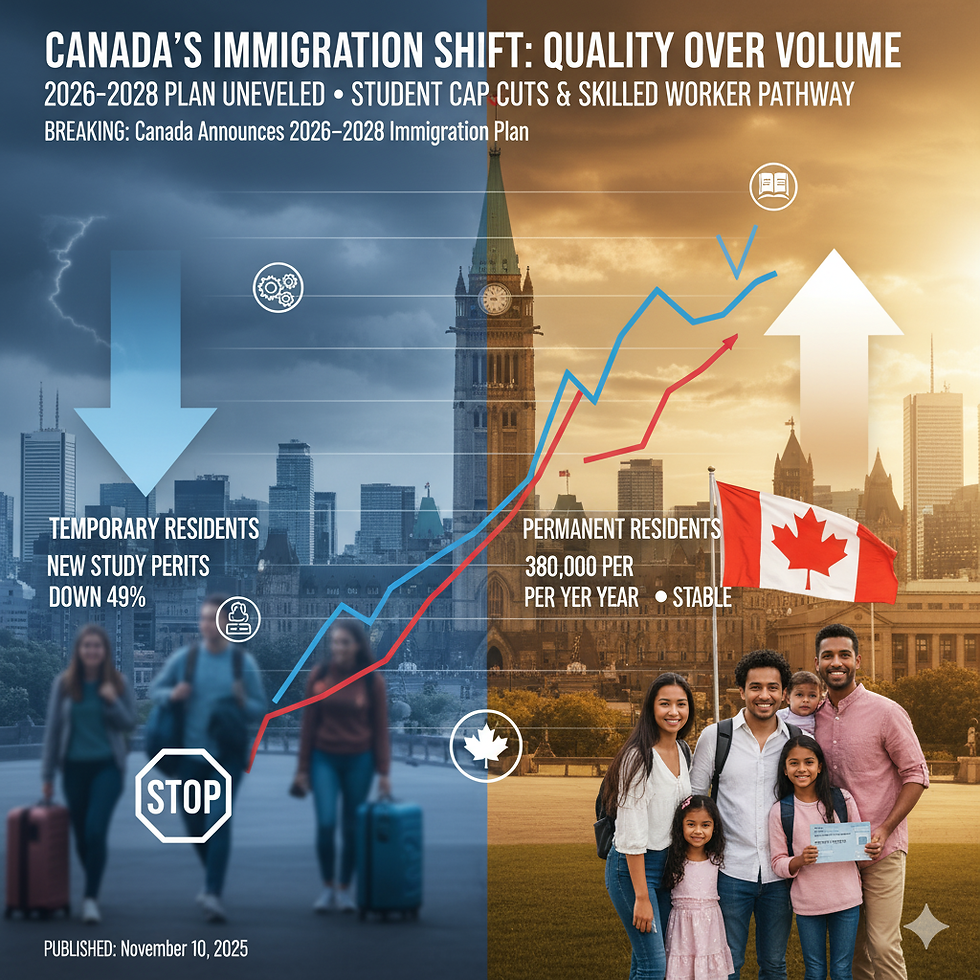Canada Immigration Ends Temporary Public Policy Allowing Visitors to Apply for Work Permits from Within the Country
- Ansari Immigration

- Aug 29, 2024
- 4 min read
In recent years, Canada has been a beacon of hope for many seeking new opportunities. Its immigration policies have often been seen as welcoming and progressive. However, a significant change is on the horizon that could impact many potential immigrants: the end of the temporary public policy that allowed visitors to apply for work permits from within Canada. This blog will delve into the implications of this policy change, providing valuable insights for those planning to immigrate to Canada.
Understanding the Temporary Public Policy
During the COVID-19 pandemic, Canada introduced a temporary public policy that enabled visitors to apply for work permits from within the country. This measure was designed to address labor shortages and provide flexibility to those already in Canada on visitor visas. The policy was initially set to expire on February 28, 2025. However, recent developments indicate that this policy will conclude earlier than anticipated.

Why the Policy is Ending
The decision to end this policy stems from several factors:
Economic Recovery: As Canada recovers from the economic impacts of the pandemic, the labor market is stabilizing, reducing the need for such temporary measures.
Policy Evaluation: The government is continually assessing its immigration policies to ensure they align with long-term economic and social goals
Return to Pre-Pandemic Norms: With the pandemic's effects waning, Canada is gradually reverting to its standard immigration procedures.
Implications for Prospective Immigrants
The end of this policy has significant implications for those planning to immigrate to Canada:
Application Process: Visitors will no longer be able to apply for work permits from within Canada. Instead, they must apply from their home countries or other countries where they have legal status.
Increased Planning: Prospective immigrants will need to plan their applications more carefully, considering processing times and entry requirements.
Potential Delays: The change may lead to delays for those who were counting on applying from within Canada, as they will now need to navigate the application process from abroad.

Alternatives for Immigrants
Despite the end of this policy, there are still numerous pathways for immigrants to work and live in Canada:
Express Entry: A popular option for skilled workers, Express Entry is a points-based system that ranks candidates based on factors like age, education, work experience, and language proficiency.
Provincial Nominee Programs (PNPs): These programs allow provinces and territories to nominate individuals who wish to immigrate to Canada and settle in a particular province.
Family Sponsorship: Canadian citizens and permanent residents can sponsor family members to come to Canada as permanent residents.
Question and Answer Section
Here are some common questions that potential immigrants might have regarding this policy change:
Can I still apply for a work permit while visiting Canada?
No, with the end of the temporary policy, visitors must apply for work permits from outside Canada.
What are the alternatives if I can't apply for a work permit from within Canada?
Consider applying through Express Entry or a Provincial Nominee Program, or explore family sponsorship options.
How can I stay updated on changes to Canada's immigration policies?
Regularly check the Immigration, Refugees and Citizenship Canada (IRCC) website and subscribe to updates from reputable immigration news sources.

The end of the temporary public policy allowing visitors to apply for work permits from within Canada marks a significant shift in the country's immigration landscape. While this change may pose challenges, it also underscores the importance of understanding and navigating Canada's immigration policies effectively. By staying informed and exploring alternative pathways, prospective immigrants can still pursue their dreams of living and working in Canada.
How does this change impact international students in Canada?
The recent changes to Canada's immigration policy, specifically the end of the temporary public policy allowing visitors to apply for work permits from within the country, have significant implications for international students in Canada. Here's how these changes impact them:
Impact on International Students
Work Permit Applications
International students in Canada who wish to work after graduation typically apply for a Post-Graduation Work Permit (PGWP). The recent changes mean that students can no longer apply for a PGWP at the Canadian border, a process known as "flagpoling" which allowed for same-day processing. This change aims to reduce the strain on border resources and ensure that immigration officers can focus on other priorities.
Study Permit Caps and Attestation Letters
The Canadian government has introduced a cap on the number of new international student permits, limiting it to approximately 360,000 for 2024. This cap is part of a broader strategy to stabilize the growth of international students in Canada. Each province will have a specific allocation, and students will need a Provincial Attestation Letter (PAL) to apply for a study permit. This requirement does not apply to students in master's, doctoral, or elementary/secondary education programs.

Post-Graduation Work Permit (PGWP) Eligibility
Starting in September 2024, students enrolled in programs under curriculum licensing arrangements with private colleges will no longer be eligible for a PGWP. This change aims to close a loophole and ensure that only students from institutions with adequate oversight can access the work permit program.
Financial Requirements
There has been an increase in the financial requirements for international students, with the minimum proof-of-funds eligibility requirement rising to CAD $20,635. This increase is intended to ensure that students have sufficient resources to support themselves while studying in Canada.
Questions and Answers
Can international students still work off-campus while studying?
Yes, international students can work off-campus. The waiver on the 20-hour-per-week limit has been extended to April 30, 2024, allowing students to work more hours during this period.
What are the new financial requirements for international students?
The minimum proof-of-funds eligibility requirement has increased to CAD $20,635 to ensure students have adequate financial resources.
How do these changes affect the pathway to permanent residency for international students?
Despite the changes, international students can still pursue permanent residency through programs like Express Entry and the Provincial Nominee Program, which value Canadian education and work experience.

These policy changes reflect Canada's ongoing efforts to balance the integrity of its immigration system with the benefits that international students bring to the country. While these changes may pose challenges, they also aim to ensure that students have a supportive and enriching experience in Canada.




Comments